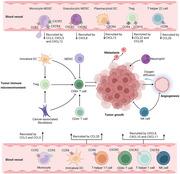- Record: found
- Abstract: found
- Article: found
Role of chemokine systems in cancer and inflammatory diseases

Read this article at
Abstract
Chemokines are a large family of small secreted proteins that have fundamental roles in organ development, normal physiology, and immune responses upon binding to their corresponding receptors. The primary functions of chemokines are to coordinate and recruit immune cells to and from tissues and to participate in regulating interactions between immune cells. In addition to the generally recognized antimicrobial immunity, the chemokine/chemokine receptor axis also exerts a tumorigenic function in many different cancer models and is involved in the formation of immunosuppressive and protective tumor microenvironment (TME), making them potential prognostic markers for various hematologic and solid tumors. In fact, apart from its vital role in tumors, almost all inflammatory diseases involve chemokines and their receptors in one way or another. Modulating the expression of chemokines and/or their corresponding receptors on tumor cells or immune cells provides the basis for the exploitation of new drugs for clinical evaluation in the treatment of related diseases. Here, we summarize recent advances of chemokine systems in protumor and antitumor immune responses and discuss the prevailing understanding of how the chemokine system operates in inflammatory diseases. In this review, we also emphatically highlight the complexity of the chemokine system and explore its potential to guide the treatment of cancer and inflammatory diseases.
Abstract
Chemokines are a large family of small secreted proteins that coordinate and recruit immune cells into and out of tissues and to participate in regulating the interactions between immune cells. The chemokine/chemokine receptor axis is involved in the progression of multiple malignancy types and almost all inflammatory diseases. This review summarizes recent advances of chemokine system in antitumor and protumor immune responses and discuss the prevailing understanding of how the chemokine system operates in inflammatory diseases. Modulating the expression of chemokines and/or their corresponding receptors on tumor cells or immune cells provides the basis for the exploitation of new drugs for clinical evaluation in the treatment of related diseases.
Related collections
Most cited references413

- Record: found
- Abstract: found
- Article: found
Inflammatory responses and inflammation-associated diseases in organs
- Record: found
- Abstract: found
- Article: not found
Chemokines in the cancer microenvironment and their relevance in cancer immunotherapy
- Record: found
- Abstract: found
- Article: not found
